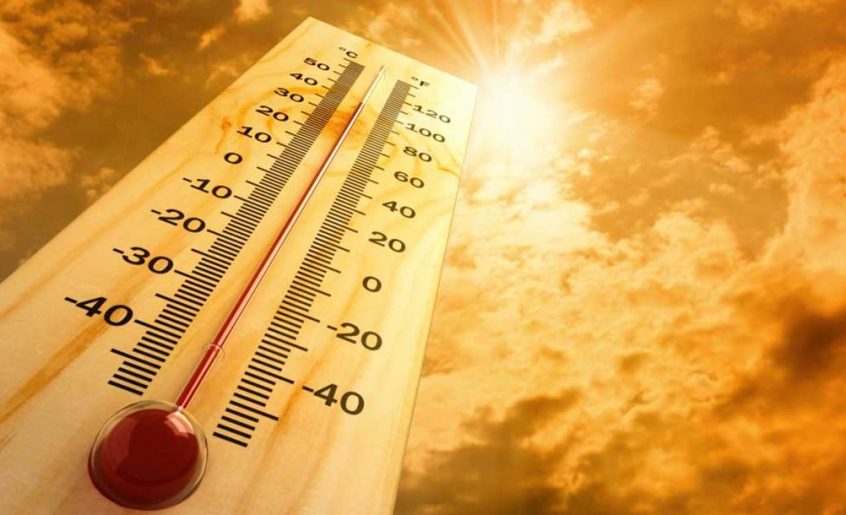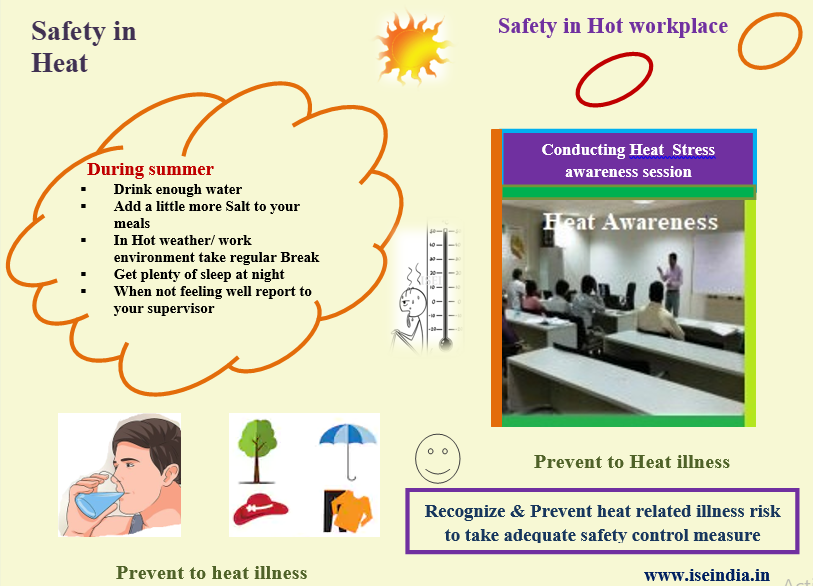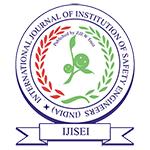Heat Stress Prevention at Workplace

Volume 3, Issue 2, April – June 20
Heat Stress Prevention at Workplace
Adil Naseer
SMISE, Tech IOSH, B. Tech(M.E), Level 7 IDip PG OSHM, NEBOSH IGC, IOSH MS, IMS Internal Auditor – ISO 9001/14001/45001 – with 08+ yrs Experience in QHSE Field & Currently working at Hamad International Airport – Qatar as QHSE Professional
Email id: hsefmm@gmail.com
Abstract:
Heat Stress is major threaten for workmen at workplace during summer season. It creates health related issue to workmen due to exposure of high temperature at work place. This studies is to carried to minimize or reduce the risk related to heat stress and its result illness or death. This article is very helpful on Heat Stress Management at Workplace. It is targeting employers, managers, supervisors, workers, joint health and safety committee members, health and safety representatives, employer associations, and health and safety Professionals. The articles provide guidance on how to recognize, estimate, prevent and treat heat stress at work. It can also be used as a Safety guideline by employers for avoiding discomfort from hot environment at work. Heat stress can increase stress and fatigue which can lead to any serious health conditions for Employees working in hot environments and also it may increase the workplace Misfortunes events. Poor awareness among employers and employees on exposure to heat stress is common & it needs to be sorted out. These recommendations are proposed and to be used by employers and employees those who are working under severe hot climatic conditions at their workplace. The Heat Stress Awareness is to provide information and advice on preventing managing and controlling heat stress in the various workplaces. It is our hope that these guidelines of this article will be adopted by all industries and implemented at workplaces to control risk related to heat stress.
Objective
The aim of this Article is to provide workers with the necessary awareness and suitable strategies for recognizing the symptoms of heat stress and how to safely protect themselves from heat related exposures and illnesses at workplace.

Learning Objectives: By the end of this article, readers will be able to
- Define heat stress, heat strain and heat-related illnesses (HRI)
- Identify the symptoms of heat stress
- Recognize the HRIs and state first aid measures for each
- Recognize factors that may affect you during outdoor works
- Identify means of heat stress prevention
- Explain the different responsibilities of all staff during the hot period, when heat stress might occur
1. Introduction
What is Heat Stress? Heat stress occurs when our bodies are overheated and our internal “cooling system” cannot cool us down fast enough or properly. Our body reacts to overheating by sweating and blood flow to the surface of the skin’s, which may lead to dehydration.

Fig. 1
When hot & high humidity environmental conditions appear, the sweat has nowhere to go due to the high amount of water vapor in the atmosphere, which can aggravate to the heat stress symptoms and become very uncomfortable for the body.
Millions of workers from various industries are exposed to heat in their workplaces. Even though sickness from exposure to heat is avoidable, every year, thousands become sick from occupational heat related various exposures, and some cases are recorded as mortal. Most outdoor fatalities, 50% to 70%, occur in the first few days of working in warm or hot environments because the body needs to build a tolerance to the heat gradually over time. Lack of familiarization represents a major risk factor for fatal outcomes.
Work related risk factors (see clause 2) for heat illness include heavy physical activity, warm or hot environmental conditions, lack of familiarization, and wearing clothing that holds in body heat. Hazardous heat exposure can occur indoors or outdoors and can occur during any season if the conditions are right, not only during heat waves. The following is a list of some industries where workers have suffered heat-related illnesses.
2. Heat illness or heat related illnesses Symptoms & signs that your body is getting too hot:
You feel tired and less mentally alert makes you prone to accidents; You may sweat and start exhibiting dehydration if you don’t replace the fluids and salts (called electrolytes); Heat rash may appear as a result of sweat glands swelling and getting plugged up, Direct exposure to sun can result in sunburn.

Fig. 2.1
Prolonged heat stress may result in Heat Related Illnesses (HRI) with the following progression:
- Heat rash
- Heat cramps
- Heat exhaustion
- Heat syncope or fainting
- Heat stroke

Fig. 2.2
Heat Related illness (HRI)

Fig. 2.3, Sources, ISEI manual
Urine Color Chart

Fig. 2.4, Sources, ISEI manual
3. Factors that may affect the staff including workmen
There are two main factors that may affect the staff, while working outdoors during the hot weather: Operational factors and Personal factors
3.1 Operational factors: It includes
- Shift Timing
- Limited shade cover
- Confined space
- Availability of ventilation
- Clothing and PPE
3.2 Personal factors: It includes
- Acclimatization
- Medical condition
- Physical fitness (age, weight)
- Alcohol and caffeine
- Eating habits
- Sleep
- Gender
You have higher risk of heat stress if:
- You are not used to working in the heat
- You have chronic illnesses like heart disease or diabetes
- You are overweight
- You drink alcohol, too much caffeine or take drugs
- You ate too much or too less
- You are already dehydrated
- You wear heavy or tight clothing that prevents your body from fighting heat.
4. First Aid for Heat Stress
- Remove person from heat.
- Call for HELP!
- Lie person down and elevate feet
- Loosen clothing
- Pour water on them or use damp cloth
- Apply cold compress if available
- Give small sips of water if conscious
- Use a fan where available to cool body temperature
- Wait for Emergency Services
5. Responsibilities of employer and workers to control heat stress related risk:
Employers: Employers should develop a written health and safety policy outlining how workers in hot environments will be protected from heat stress. As a minimum, the following points should be addressed.
- Regulate work practices as necessary when workers criticize of heat stress.
- Make controlling exposures through engineering controls the primary means of control wherever possible.
- Manage heat stress trainings for all staff and check familiarization for new workers, workers who have been off the job for a while, and workers with medical conditions.
- Offer worker education and adequate trainings, including sporadic Tool box talks briefings on heat stress during hot weather or during work in hot environments and Monitor the workplace to determine when hot conditions arise.
- Determine whether workers are drinking enough water.
- Regulate a proper work / rest management for Employees.
- Arrange first-aid training for workers.
- When working in manufacturing plant, for instance, a contractor may wish to adopt the plant’s heat stress program if one exists.
Educating Workers about Heat Stress
Educate your workers so they understand how important it is they keep themselves hydrated and cooled off. Ensure they have adequate designated sheltered areas where they can rest, cool down and re-hydrate. If extreme heat environment is unescapable, providing employees with some recommended liquids or air-cooled clothing may be necessary.
When we suggest hydrating your worker, we mean with water or electrolyte replenishment drinks, do not offer caffeinated drinks, alcoholic drinks and sweeteners, as these contribute to dehydration. By providing your workers with information and resources to keep their bodies safe and hydrated, you ensure employee satisfaction, increased productivity all of which helps in achieving business goals.

Fig. 3, Sources, ISEI manual
Workers: Following below are few example of responsibility of workers to prevent heat related Illness at work place in any industries:
- Drink a lot of cool water (or an electrolyte solution). You may need a quart an hour or more, depending on conditions. Drink even if you don’t feel thirsty.
- Workers to take regular breaks in an air-conditioned or cool sheltered area at workplace.
- Always Dress accordingly as suitable clothing when you are in the sun or under the Hot climate.
- Stay physically fit.
- Don’t use alcohol.
- Ask your doctor about prescription drugs you’re taking.
- Use the buddy system. Check your colleague if he is having any signs of heat stress.
- Know what to do if you or your coworker shows any symptoms.
- Notify your supervisor and stop work if you notice any major symptoms
- Ensure application of the requirements of this instruction by all employees and subcontractors.
- Ensure that this instruction is included in the “terms and conditions” of all contract with subcontractors.
- Ensure that all concerned employees and subcontractors are trained on the requirements of this instruction.
- Ensure proper Uniform, PPEs and equipment are available.
- Ensure work schedule is posted in work areas and are available to any employee and subcontractor
- Perform at least one fortnightly HSE Inspection in outdoor works to monitor compliance with this instruction and send the inspection report to HSEQ / Safety Manager.
- Take disciplinary actions against FMM employees or subcontractors in case the requirements of this instruction are not followed up.
- Work Shift Schedules posted in the work area. Breaks as required by the hourly heat index
- Enough of cool water available per employee per shift. 1 cup or bottle available for each employee.
Guide: Procure enough material resources to all employees working outdoors and subcontractors as per below figure (Fig. 4)

Fig. 4
5 STEPS TO BEAT THE HEAT

Fig. 5, Sources Google
6. Objectives review: By the end of this article, readers will be able to:
- Identify what is heat stress
- Recognize what are heat related-illnesses and defferent kinds
- Recognize factors that may affect staff during outdoor works
- Identify means of heat stress prevention
- Apply best first aid in case of any incident or accident
- Explain the different responsibility of all staff during this period
Through the years, The Institution of Safety Engineers (India) as an organization has been promoting safe system of work through information, instruction, training and supervision, with a collaborative effort from every Head of the department.
As a Senior Member of this Esteemed Institution it’s a privilege to share the best practices of health and safety across the globe. Health and safety is not only HSEQ (Health, Safety, and Environment & Quality) department responsibility it is everyone’s responsibility.
Not just one person it is EVERYONE- whether you are a Manager, an ordinary Technician or a Cleaner you have the responsibility to ensure your safety and be fully aware of the risk involved and possible consequence that could result from what you are about to do.
Remember, nothing that we do is so urgent that we cannot take time to do it safely. What you don’t know can hurt you and what you knew can help you.
Together, you and me and every one of us let us be safety committed and honoring this commitment by working safely. Your safety is your priority…together we go home safely.
Remember if conditions change and the potential for a heat related illness is identified, we must use our Stop work Authority immediately, so that corrective action can be taken.
“HEAT STRESS CAN BE DEADLY”–PROTECT YOURSELF FROM HEAT RELATED ILLNESS
WE ALL CAN WORK TOGETHER TOWARDS A MUCH CLEANER AND SAFER WAY!
If it is not safe… Don’t do it!
References
- Safety talk ideas & Pinterest Safety Posters
- ISEI Manuals & Journals
- DOSH, 2016, Guidelines on Heat Stress Management at Workplace
- NIOSH [2016] occupational exposure to heat and hot environments
- QCS – 2014
- Online H &S Articles /Books / blogs. – From IOSH H&S Professional Members
